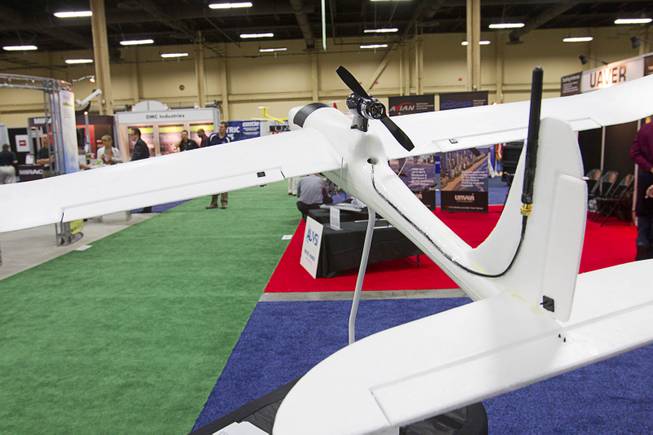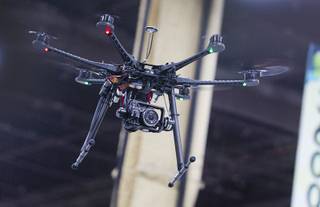
A plane with an Applewhite Aero autopilot system is displayed Thursday, Aug. 9, 2012, during the Association for Unmanned Vehicles Systems International convention at Mandalay Bay. The autopilot system has the potential to turn low-cost hobby planes into drones that can be used for basic research.
Friday, Aug. 10, 2012 | 2 a.m.
Related story
They can fly, swim and even walk, carrying cameras or cargo long distances through often-treacherous terrain.
The military has researched and used unmanned vehicle systems, commonly known as drones, for 40 years in faraway war zones. The vehicles have begun crossing over more and more into the civilian and commercial realms, where proponents say the technology has the potential to save lives and keep workers out of harm’s way.
But the devices, which often are small, portable and relatively affordable, also are uniquely suited for surveillance, leading some to worry about potential misuse and invasion of privacy.
An army of drones invaded the Mandalay Bay Convention Center this week as part of the Association for Unmanned Vehicle Systems International’s convention, which drew 567 exhibitors from about 40 countries.
“The market for unmanned systems has been pretty much defense-related for the last several decades. We are starting to see a shift into the civil and commercial markets now,” said Gretchen West, executive vice president of the association. “The biggest has been for law enforcement and first responders.
“There’s a lot of (unmanned aircraft systems) being used for border security. ... Police forces are looking to use UAS to do things like monitor crime scenes, do surveillance over traffic congestion or look for missing people in the woods.”
The vehicles, which can traverse air, land or sea depending on their setup, already are being used in a variety of applications, including research, exploration, security, maintenance and cinematography.
Many of the flying drones are compact, are highly maneuverable and carry cameras, allowing them to discretely peer in windows or track a target.
Potential privacy issues raised by the proliferation of drones have caught the attention of the American Civil Liberties Union, which is working to start discussions about the laws and regulations needed to ensure the devices aren’t misused, said Allen Lichtenstein, general counsel for ACLU Nevada.
“To have unrestricted use of (drones) looking into areas where people have a reasonable expectation of privacy is one step further into this surveillance society we’re hurtling toward,” he said. “There are a lot of questions that need to be answered. Laws need to be put in place.”
Metro Police do not own drones and have no intention of purchasing any soon, although the department has discussed potential uses of the technology, said Officer Marcus Martin, a Metro spokesman.
Martin said budget constraints and airspace restrictions from Nellis Air Force Base and McCarran International Airport have prevented the department from seriously pursuing the technology.
Exhibitors at the convention said unmanned vehicle systems have a wide range of uses beyond military or law enforcement purposes, many of which still are being discovered.
Paul Applewhite, president of Seattle-based Applewhite Aero, compared the growth of the drone industry to the growth of the general aviation industry, which took decades to develop its complex passenger and cargo transport network.
Applewhite Aero manufactures an auto-piloting system with GPS targeting for remote-control airplanes. It allows users to punch in a location and watch the plane fly itself there.
“It’s basically a toy airplane that we’ve added autopilot to,” said Applewhite, who envisions the technology being used for humanitarian aid, such as flying medicine and supplies to remote villages or disaster zones.
The Applewhite Aero auto-pilot system costs about $600, 10 percent of what other commercial systems cost.
Technological advances continue to drive down the cost of unmanned vehicle systems — they now start as low as $5,000 — which has helped fuel innovation and adoption of the technology, Applewhite said.
“Everybody thinks unmanned aerial vehicles are a bad thing,” he said. “It depends on what you use it for.”


Join the Discussion:
Check this out for a full explanation of our conversion to the LiveFyre commenting system and instructions on how to sign up for an account.
Full comments policy